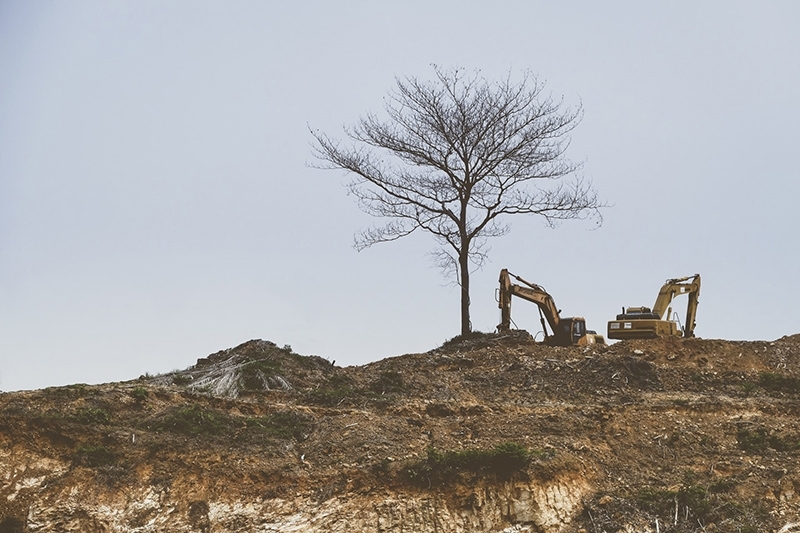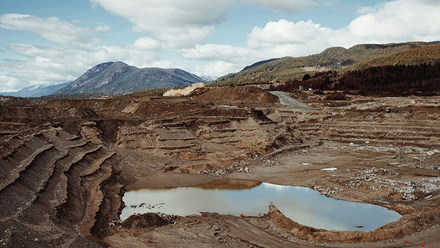How communities can influence working policies, proposals and operations
This section provides suggestions on why, when and how the local community can get involved in the minerals planning process.

This guide covers the information that communities might need to participate effectively, where to find it, steps that can be taken before a planning application is lodged, when an application is being considered, or when an application is refused, and goes to appeal, or is approved and how to best engage with mineral operators when a site is in operation.
It is a good idea to discuss minerals issues with planners and the industry at the policy and planning application stages and, if extraction is permitted, during operations so that concerns can be aired and, if possible, be dealt with.
Planners and the industry should keep the public well informed at all stages.
Operators should provide full contact details at a clearly visible locations on the margins of their sites so that concerns and complaints reach the right people. They should, when practicable, provide view points with information boards and, arrange open days and educational visits so that people can see what takes place in quarries and how potential impacts are dealt with.
Why get involved?
Quality of life and property values can be affected by nearby developments if there are concerns about significant environmental nuisance. Prices can also be affected before an application is made or approved because of perceptions and fears, for example if areas of search for minerals, minerals resource safeguarding areas, site location criteria or site applications are proposed in draft minerals development plans. Prices may recover after a site commences operations and residents can judge the impacts by experience, depending on the nature of those operations and the quality of site management.
Therefore, it is prudent for potentially affected home and local business owners to get involved at an early stage, seek factual information on the proposal and its potential effects and register and discuss their concerns about environmental nuisance. There are also potential opportunities for securing community benefits, if mineral proposals were to go ahead, which might otherwise be lost.
Mineral Planning Authorities (MPAs) and mineral operators should be very willing to listen to constructive suggestions on how problems can be reduced and benefits can be secured – and this needs community involvement. Pre-application discussions can be used to alter and improve planning applications.
Many operators convene a community liaison group to advise them on problems and to discuss solutions during mineral working and welcome community representatives to engage in discussions. In many areas, local residents' groups have been formed to influence mineral working because this helps identify and often reduces problems. Therefore, if mineral working is a major feature of your area it makes sense to establish a more frequent and regular dialogue with the mineral operators before, during and after extraction.
When?
The main formal opportunities for anyone to influence mineral developments in the local area area are -
- when draft minerals and waste plan documents are being prepared by the local MPA, it will probably consult the public on ‘issues and options’ and sometimes also a ‘preferred strategy’, and may hold local exhibitions and organise public meetings to explain its ideas and proposals before inviting comments
- public consultation of the draft minerals and waste plan document and the sustainability appraisal before it is submitted to the government
- at public examination of the draft final policy document before it is declared ‘sound’ with or without amendments by a government-appointed Inspector (or sent back for further more substantial changes)
- when an environmental impact assessment for a proposed mineral operation at a particular site is published
- during pre-application discussions with the proposed mineral operator before making an application at a particular site
- when a planning application is lodged. Owners will be contacted directly if property is immediately affected because it is near the site involved, or if people have already registered an interest in being involved. If neither of these apply, information can still be gathered from site notices, advertisements in local papers and in local libraries and the MPA's regular list of current planning applications on the Internet
- at a public inquiry if an operator lodges an appeal against a local authority refusal; and
- during operation and restoration of a site, usually through a community liaison group convened by the operator.
If you live in an area where mineral working is taking place or is likely to take place in the future you can keep yourself informed at any time.
How?
Individuals are entitled to make individual representations, but it is often more effective to join an existing environmental organisation and/or a local community group, or to form a new group, perhaps as a local branch of a national organisation. It is important to learn as much as possible about the planning and environmental permitting systems, about mineral working and how the two interact.
If a group is formed, it is useful to identify people who have existing relevant knowledge and skills and who are best equipped to draft representations and, if necessary, to speak at public sessions. Find out in advance where to send representations and, most importantly, by when. Get in touch with the MPA to be registered on its list of consultees.
What information is needed?
It is important to compile information from reliable sources. Particularly find out why and how mineral operations are undertaken in your area, the potential effects of these and how these can be minimised. Much relevant information can be found here. But it is also useful to talk to local mineral operators and visit quarries on open days. Much useful information can also be gathered from other communities affected by quarrying who have learnt the 'hard way'. Some organisations, including the Campaign to Protect Rural England (CPRE) also offer planning advice.

How to influence local planning policies?
Read any existing minerals plans that have already been approved and adopted which are in force in locally. If a new core strategy or mineral development document is being prepared, read any public consultation draft that is available. Send comments on draft minerals extraction policies and proposed criteria for deciding planning applications to the MPA indicating which are acceptable, could be made acceptable if modified - if so, say how, or are unacceptable in any circumstances. Give brief, clear reasons for the comments made. It is generally more effective to state your opinion in your own words than just signing a general petition or a campaign postcard.
Consider the MPA's response to any previous public consultations on the plan and if you disagree say so. When the draft plan is eventually submitted for public examination, having been revised after the consultation process, and you still disagree, make representations to the independent planning inspector who conducts the examination. The inspector will help you make your case in person if you wish, but if you feel you need expert help be prepared to identify and brief an informed representative to make the case, if there is an opportunity to speak at the examination of the draft plan. Concerned individuals may find it easier to make representations collectively through a local organisation or local branch of a national body if they do not feel comfortable about doing so alone.
Prior to a planning application
It is sensible to understand how the minerals planning and environmental permitting systems work and the nature and impacts of mineral working.
If there are areas allocated for mineral working in the adopted minerals development document for the local area, find out which companies operate sites in it and their operational reputations. Depending on the mineral involved, it is possible to check whether the operator is a member of a trade association such as the Mineral Products Association, British Aggregates Association, British Ceramic Confederation, Silica and Moulding Sands Association, Mining Association of the UK, or the Confederation of United Kingdom Coal Producers, or contact community liaison groups or residents in other areas where the operator is also undertaking extraction.
Any responsible minerals operator will be willing to discuss how the operation might be best undertaken and the best options for site restoration before an application is lodged.
When a planning application is lodged
It is important to be alert to the site notices and notices in local newspapers that advertise any application and then visit the office of the MPA to read the application documents or consult these on the planning authority website. If possible, check whether the application conforms to policies in existing development plan documents or, if not, ask officials at the MPA whether it does.
If the proposal does conform it is likely to be approved if it is well designed and takes into account and properly mitigates possible adverse impacts of any special characteristics on the site or elsewhere if affected by the proposals, such as transport or landscape impacts, for example.
If it does not conform then it is more likely to be refused, unless there are overriding reasons for departing from provisions in the plan to approve it.
If an application seems likely to be approved it is better to try to secure positive improvements to the proposal than to simply oppose it in principle. Make your views known to the MPA - whether the proposal is considered unacceptable, acceptable subject to specific modifications or conditions and conditions, or acceptable as it stands. Support your assessments with convincing reasons. The better the evidence provided the more weight views will carry.
When clarification is needed
To understand the application properly you are likely to need explanations and answers to your questions. This is true for the public as a whole, and it needs dialogue between the public and officers of the MPA on the one hand, and with the applicant or the applicant's agent on the other. It makes sense to know from the outset who the people dealing with the case are and how to contact them.
Good mineral operators recognise that there will be differences of view point and opinion, and are willing to discuss these in a spirit of constructive dialogue.
What questions?
Focus on matters are likely to cause the most significant problems in any representations made to the prospective operator, the Minerals Planning Authority or the Environment Agency. Matters that are relevant to decisions on planning applications might, for example, include -
- conformity with approved national and local planning policies
- amounts of mineral to be extracted
- effects on the landscape and visual intrusion from the mineral site and its plant and equipment
- emissions of noise, dust or vibrations, sometimes including disturbance from blasting, and any site lighting at night
- effects on the quality and quantity of surface and underground water, and on the local pattern of flood risk (if relevant)
- traffic to and from, and access to, the site
- arrangements for storing non-saleable excavated materials
- impacts of wildlife, plant habitats and biodiversity, especially in designated protected areas, and
- impacts on historic buildings, ancient monuments and existing or potential archaeological sites.
Check that these issues are covered by adequate proposals in the application for suitable planning and environmental licence conditions to mitigate any adverse impacts and consider what amenities will be affected by extraction -use of land, plant and wildlife habitats, historic sites and buildings. If you don't think the proposals deal adequately with these matters point that out to the applicant operator or its agent and the MPA, giving reasons.
For instance, for the operational phase of the proposed site it is important to consider -
- where the proposed site boundaries and access are located relative to homes, roads and facilities such as schools
- the potential for reducing visual intrusion – possibly by screening, and control of potential sources of nuisance such as noise, dust, site lighting, traffic including routes for taking out products, parking of vehicles waiting to be loaded, road cleaning, to consider whether these are likely to be effective
- proposed hours of working and number of days per week
- the proposed duration of the operation and
- whether the proposals for restoration and subsequent use of the site secure environmental and/or community benefits
In some cases, it may be that after due consideration of all the relevant issues your community has concerns about the overall impact of the proposal, or some impacts within it, that no amount of mitigating conditions could satisfy. In that case objections to the proposal may be lodged. One possibility might be to press for the proposal to be withdrawn. The operator then has the options to proceed as it stands despite the objections, to withdraw and redesign the application, or to withdraw it altogether.
Is the application always decided by the MPA?
Most planning applications are decided by the MPA but some are called in for decision by the Secretary of State for Communities and Local Government. This happens when an application may conflict with national policies on important matters, could have significant effects beyond the immediate locality, or gives rise to substantial regional or national controversy, or if a proposal does not conform to approved development plan policies but, nevertheless, the MPA is minded to approve it, known as a ‘departure from the plan’.
‘Called in’ applications and ‘departures’ are considered by a Planning Inspector usually through a public hearing or inquiry. There might also be an appeal lodged by the operator against the MPAs decision. If so, this also goes before a Planning Inspector. The Inspector then writes a report to the Secretary of State giving reasons for the recommended decision. The Secretary of State may or may not agree with the Inspector and that decision, too, will set out the reasons.
What can be done if an appeal is lodged by the operator?
If communities oppose the proposal, prepare a case, based on evidence, in persuasive and reasonable terms this will probably be an extension/amplification of the representations made prior to permission being denied. Standard letters sent in by opponents are taken note of but can be less influential than a well argued and presented statement.
You may wish to oppose the proposal ‘to the last ditch’. But it may be sensible not to simply oppose the proposed development but to discuss it with the applicant and identify what conditions and provisions for working and restoration would be suitable if the proposal were to be permitted, so that constructive opportunities are not lost.
Opposition will be more effective if exact and relevant reasons are given as to why the impacts would be considered wholly unacceptable at the proposed site.
What if an application is approved?
An approved application will almost certainly be implemented unless there are grounds for challenging the decision in the High Court as being unlawful. Such challenges cannot simply ask the judges to alter an unpopular decision. They must relate only to the application of incorrect or unfair procedures in reaching the decision, or that the decision did not conform in some way to the relevant law, or took the wrong matters into account, or overlooked relevant ones, or that it was wholly unreasonable.
If the Court could be satisfied on one or more of these points then the decision would be quashed and sent back to the decision-taker to consider again, the next time hopefully avoiding whatever error had occurred. What it does not mean is that the Court itself could decide the case finally in your favour.
However, if the challenge of the lawfulness of the decision was successful it is of course possible the decision taker would then decide the matter again, but that time in a way that the community felt happier with, or the applicant, having seen the Court's judgment, might withdraw the proposals or modify them.
Litigation in the High Court is very expensive and potentially risky, and expert legal advice should be taken before pursuing that option. It is more common for environmental organisations to mount such challenges than private individuals in planning matters, though that is not unknown.
If there are no realistic grounds for a successful legal challenge of a planning decision then the only constructive option is to engage with the operator through, for example, a community liaison group, so that concerns during the working phase of the site can be discussed directly and, as far as possible, resolved. Operators must observe all planning and environmental licence conditions conscientiously. These are regularly monitored and if there are breaches will be formally enforced by the MPA or other regulatory agencies involved.
It is useful to be aware of the planning and licence conditions so that it is apparent if any are being infringed, and to keep a record of what you consider to be poor working practices and performance. Problems should be discussed firstly with the operator who should be prepared to listen to concerns. In return, be prepared to listen to the operator's point of view.
If concerns remain unresolved, discuss these with the MPA, Environment Agency or Environmental Health Officer (as appropriate to the particular concern) so that they can consider whether any action is needed.
Records of good and poor practice are also valuable for use in respect of future planning applications in your area, or which might be useful to communities in other areas that might need information on a company's performance. While it is right to complain about bad performance by operators, it is also fair to acknowledge and praise good performance.
Minerals operators are in business for the long term, and will need new or extended permissions in the future to maintain the supplies of material needed by the economy. It is therefore not in their interest to develop, or refuse to repair, poor reputations and relationships with their host communities.
How to engage with minerals operators
It is a legal obligation to undertake pre-application discussions with communities. Communities should take full advantage of this. All minerals operators should make their contact details known to local communities in the areas where they have sites or want to develop them.
It is more powerful if locals, and other concerned individuals, can make views known to operators through a community group rather than as individuals.
When an operation has been permitted, many operators set up community liaison groups to discuss and deal with concerns and complaints as well as possible improvements to operations and site restoration plans. IT can be useful to discuss, without commitment, the community and environmental benefits that could be secured if the proposal were to go ahead. Representations should also be made to the Environment Agency in respect of any proposed environmental permit conditions at the prospective site and to the MPA about the planning conditions that would be necessary if, in the event, the application was to be approved.
What to expect of the MPA
The MPA should -
- maintain sufficient planning and minerals expertise to properly deal with policy issues and applications for mineral working
- undertake proper evaluation of policy options and subject them to a proper sustainability appraisal
- undertake policy development in a timely way so that existing plans are not out of date
- thoroughly monitor and review the operation of established policies governing minerals working in its area
- handle planning applications thoroughly and expeditiously
- ensure that the proper supporting information is submitted by applicants for permissions, and that necessary site surveys are completed
- consult the public properly on its draft policy documents and the planning applications it receives, listen fairly to representations that are made and take those representations properly into account in taking decisions
- monitor planning permissions regularly and respond appropriately to breaches of conditions, if necessary by effective enforcement action
- respond quickly to public concerns about impacts of current mineral operations, and
- take all of the relevant evidence fully into account in a balanced way when making decisions.
What to expect of a minerals operator
Before extraction, prospective operators should listen carefully to the views of communities, both collectively through organisations and from concerned individuals, and be willing to take reasonable concerns into account, as far as practicable, in their proposed plans.
During extraction, operators should -
- have well-trained staff accessible to the public who are able to deal with environmental, safety and restoration issues, and liaise conscientiously and effectively with the public through representative organisations and individually, arranging site visits when it is practicable and safe to do so
- undertake a well-managed and tidy operation
- observe all planning and environmental conditions thoroughly in co-operation with the planning and environmental regulators
- listen to and, as far as possible, deal with the reasonable concerns of the public and explain reasons if it is not practicable to meet their wishes.
- keep the community informed on matters such as blasting times, major new developments on sites and any necessary changes to normal operations
- effectively influence the activities of contract staff, particularly contract lorry drivers, so that they too comply with relevant planning conditions and are considerate to the local community and
- take quick action to address and correct any problems that may arise.
After extraction, operators should undertake careful and conscientious restoration and, if required, provide for a specified period after-care to a high standard to deliver community and environmental benefits for the longer term. The public liaison arrangements established during the site's working phase should as appropriate be maintained during restoration and after-care.
However, it should be understood that mineral workings are commercial operations that must be economically viable; therefore there is some commercial information that could give advantages to competitors that operators need to keep confidential. Operators need to buy or lease land for mineral working and are therefore cautious about revealing areas that they are interested in so that competitors do not step in and make a pre-emptive offer.
These precautions should not be misinterpreted as an attempt to get permission to extract minerals by stealth. When operators have the necessary ownership, leases or land options in place to consider developing firm proposals for planning and other regulatory consents, there is then a fully open process in which the public have clear rights to receive information and to express their opinions.
As regards access to minerals sites, operators are understandably cautious about allowing people into their sites except on properly authorised and controlled visits. Mineral sites are potentially dangerous places, with steep slopes, soft ground, sometimes deep water and very large plant and machinery. All site staff and authorised visitors now have to wear protective safety clothing and footwear.
Operators have a duty of care under Health and Safety legislation to visitors and even to trespassers, which is why sites have to be securely fenced and access properly controlled. Some of these controls have to be continued in the restoration and after-care phase, especially where there are steep slopes or deep water and soft ground.
What to expect of the Environment Agency
The Environment Agency should -
- clearly state policies and procedures for environmental protection
- maintain sufficient expertise to properly deal with minerals issues
- handle applications for environmental permits thoroughly and expeditiously
- ensure that the proper supporting information is submitted and that necessary site surveys are completed
- consult properly on applications for permits and to listen fairly to representations that are made
- monitor licensed sites regularly
- respond quickly to public concerns about impacts of current mineral operations
- resolve problems or carefully enforce permit conditions speedily where necessary, and
- take all of the evidence fully into account in a balanced way when making decisions
What to expect of the Environmental Health Department?
The Environmental Health Department should -
- maintain sufficient expertise to properly deal with unacceptable nuisance that may arise from minerals operations that falls outside the scope of environmental permit and planning conditions
- respond quickly to public concerns about impacts of current mineral operations
- resolve problems speedily or take legal action where necessary, and
- take all of the evidence fully into account in a balanced way when making decisions
What should mineral operators expect from the local community?
Dialogue is a two way process. Mineral operators would welcome -
- positive engagement with local communities at all stages from application to operation
- willingness to listen to the operator's point of view as well as stating clearly concerns and problems
- willingness to try to resolve issues through discussion and, when necessary, action by the operator and
- if an extraction proposal goes ahead, positive involvement in a quarry liaison group to ensure mutual benefit in the operation of the site.







